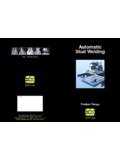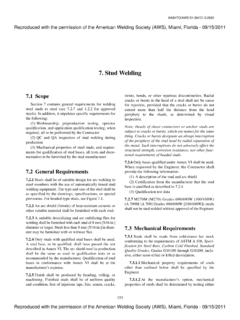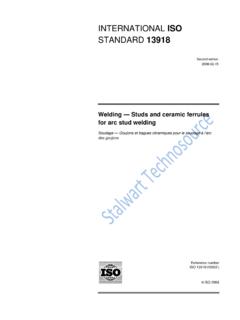Transcription of Nelson Stud Welding - USA
1 2 Nelson Stud Welding - USA Nelson Stud Welding , founded in the USA, 75 years ago, is the leading global manufacturer and distributor of weld stud fasteners and application equipment serving a broad range of markets on a worldwide basis including the automotive, construction and industrial markets. Stud Welding products are suitable for the fastening needs of virtually every industry and our products include externally threaded fasteners, shear connectors, concrete anchors, punching resistor studs, and the equipment used to apply, assemble and weld these items. Through years of design, engineering and manufacturing excellence, we have perfected the durability of our fastener products for use in high stress environments from applications such as off-road construction equipment, large expansion bridges and skyscrapers to high performance autos, nuclear power plants and equipment used in high temperature environments Nelson Stud Welding - NZ Nelson Stud Welding has been operating in New Zealand for 40 years, with operating bases in Auckland, Wellington and Christchurch.
2 Enquires: Auckland Tel: 09 820 9133 Fax: 09 820 9131 Wellington Tel: 04 233 9421 or 04 233 8131 Fax: 04 233 1072 Email: 3 The Nelson System Nelson Stud Welding is the world s leading producer of stud Welding fasteners and equipment. We invented the stud Welding process and have spread its acceptance to a wide variety of end users. Fastening with the Nelson System is quick, reliable and economical. It is a proven and tested method that successfully meets stringent fastening, material and Welding codes. It has received approvals from recognised design agencies, code bodies and industrial standard organisations. In the construction industry, Nelson pioneered the use of stud welded shear connectors and Punching Shear Resistor Studs.
3 The Process Electric-Arc stud Welding is the most common process and is utilized whenever metal is fabricated. It is used to best advantage when the base plate is heavy enough to support the full strength of the welded studs, but is sometimes used with lighter gauge material. The Stud is held in the Welding gun with the end of the stud placed against the work. The cycle is started by depressing the trigger button start switch. The stud is then automatically retracted from the work piece to establish an arc. The arc continues for predetermined period of time until portions of the stud and the base plate have been melted. Then, the Welding gun automatically plunges the stud into the molten pool of metal and holds it there under spring pressure.
4 At the same time, the Welding current is stopped and, when the molten metal solidifies, the weld is completed and the Welding gun is removed from the stud. The molten metal is held in place by a ceramic ferrule which also serves to shield the arc. The weld metal is deoxidised by a flux in the weld end of the stud. This results in a dense, strong weld which will develop the full strength of the stud and base plate. The weld cycle depends on the diameter of the fastener and materials being joined and varies in time from 1/10 to 1-1/2 seconds. Welding currents range from 250 to 3000 amps. 4 Welding Thru deck The best Welding results are achieved through adherence to recommended job-site procedures and conditions.
5 Factors such as painted beam flanges, water, deck fit-up to the beam, and inadequate power can seriously hamper satisfactory Welding . Here are some important site requirements: Top flanges of beams must be unpainted (or at least a strip where the studs are to be welded). Remember if fire protection coating is applied to the rest of the beam (top uncoated) prior to stud Welding , that touch up may be required after the studs have been welded. (The heat from stud Welding may activate the fire protection) The beams should be free of heavy rust and mill scale The beams should be free of dirt, sand and other materials Galvanised beams will need to be ground back to remove the galvanising Water on the deck, or between the beam and deck must be removed before Welding Gun setup for weld-thru deck application Shear Connectors Nelson headed shear connectors deliver code specified shear strength values as used in composite construction, securing concrete to steel structural components.
6 Nelson shear connectors meet requirements of the following codes: 5 AS/NZS Structural steel Welding Part 2: Stud Welding (steel studs to steel) AWS Structural Welding Code Steel AWS Structural Welding Code Stainless Steel AWS Structural Welding Code / AASHTO Standard Specification for Highway Bridges Canadian Standards Association W59 Welded Steel Construction AISC Manual of Steel Construction Allowable Stress Design AISC Manual of Steel Construction Load & Resistance Factor Design See also: ICC-ES Evaluation Report ESR-2856 Nelson Shear Connector Studs Shear connectors are typically used in composite steel construction for holding concrete slabs to steel members to resist shear forces and increase shear loading capacity in steel buildings, bridges, columns caissons, containment liners, etc.
7 They also act as embedment anchors on miscellaneous embedded plates, frames, angles, strip plates, attachments and connections. Shear Studs held in stock D Diameter Nominal Length L Length A H Burn off M13 50 54 8 25 4 M13 100 104 M13 150 154 M16 65 69 8 32 4 M16 100 104 M16 150 154 M19 50 55 10 32 5 M19 75 80 M19 80 85 M19 95 100 M19 100 105 M19 125 130 M19 150 155 M19 175 180 M19 200 205 M19 250 255 M19 300 305 M22 100 105 10 35 5 M22 125 130 M22 150 155 M22 200 205 M22 250 255 M25 100 106 13 41 6 M25 125 131 M25 200 206 Please note that limited stocks are held on some sizes Other sizes may be available, so please contact us. 6 Short form specification To ensure that certified products are used, the following specification is suggested.
8 Headed anchors shall be Nelson Shear Studs, flux filled Welding to plates as shown on drawings. Studs shall be made from cold drawn steel Grades to I C -1010 through C 1020 per ASTM A-108 and shall be welded per manufactures recommendation Physical Properties of Shear Connectors Diameter As Nominal Area mm2 As fy Yield Kg (min) As fs Tensile Kg (min) M13 4,445 5,334 M16 6,963 8,355 M19 10,024 12,029 M22 13,630 16,356 As Area of stud shank fs Ultimate strength (tensile): Cold Finished low carbon steel M13, M16, M19, and M22 420 Mpa min C max fy Yield strength 345 Mpa min Mn max Elongation 20% P Max Reduction Area 50% min S max 7 Tension capacity The following data is presented as guideline as only and are based on embedded studs and adequate spacing for full capacity development.
9 Appropriate safety factors should be applied based on actual use. Shear Stud tension capacity in concrete D Diameter L Length Before weld length (1) After Weld Length Dh Head Diameter (2) Le (mm) (3) Ultimate Embedded Strength of Anchor {Pue} (4) Tension Capacity (Puc) kN (5) (6) (7) Fc=3000 kPa Fc=4000 kPa NWT Fc=5000 kPa NWT Fc=3000 kPa SLWT Fc=4000 kPa SLWT Fc=5000 kPa SLWT Fc=3000 kPa ALWT Fc=4000 kPa ALWT Fc=5000 kPa AlWT M13 54 50 25 42 M13 104 100 25 96 M13 154 150 25 142 M16 69 65 32 57 M16 104 100 32 92 M19 80 75 32 65 M19 85 80 32 70 M19 100 95 32 85 M19 105 100 32 90 M19 130 125 32 115 M19 155 150 32 140 M19 180 175 32 165 M19 205 200 32 195 M22 105 100 35 90
10 M22 155 150 35 140 M22 205 200 35 190 Notes: (1) Length overall after Welding to plate (2) Le Length of embedment under head of stud (3) Pue (4) Puc Ultimate concrete tension capacity from formulae where Puc Puc controls Puc = 0 (Le) (Le + Dh) f1c (5) NWT Normal weight concrete (C = 1) (6) SLWT Sand Lightweight Concrete (C = ) (7) ALWT All Lightweight Concrete (C = ) Shear capacity Headed shear studs embedded in concrete with an embedment length more than four times their diameter are capable of developing full shear capacity. Spacing is not as sensitive in shear as in tension. Spacing four times diameter between studs in plane perpendicular to the shear force and six times diameter in the direction of the shear force is generally adequate to develop full stud capacity.








